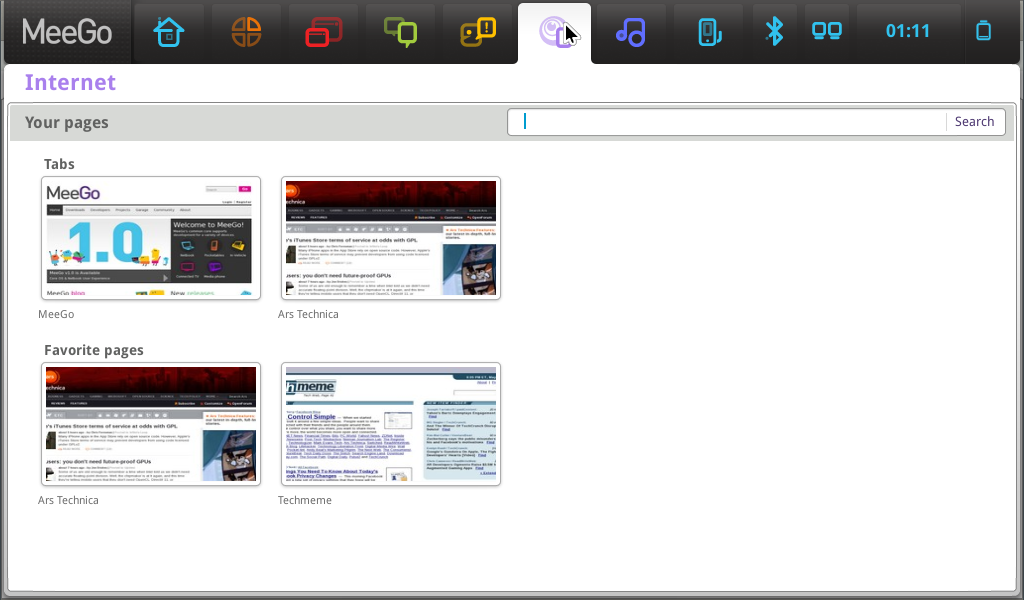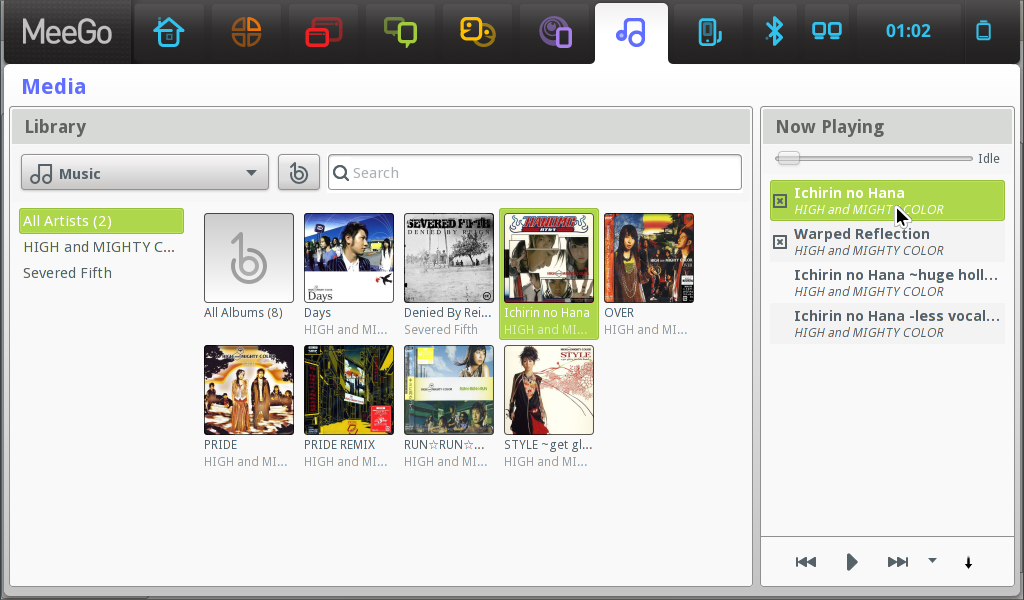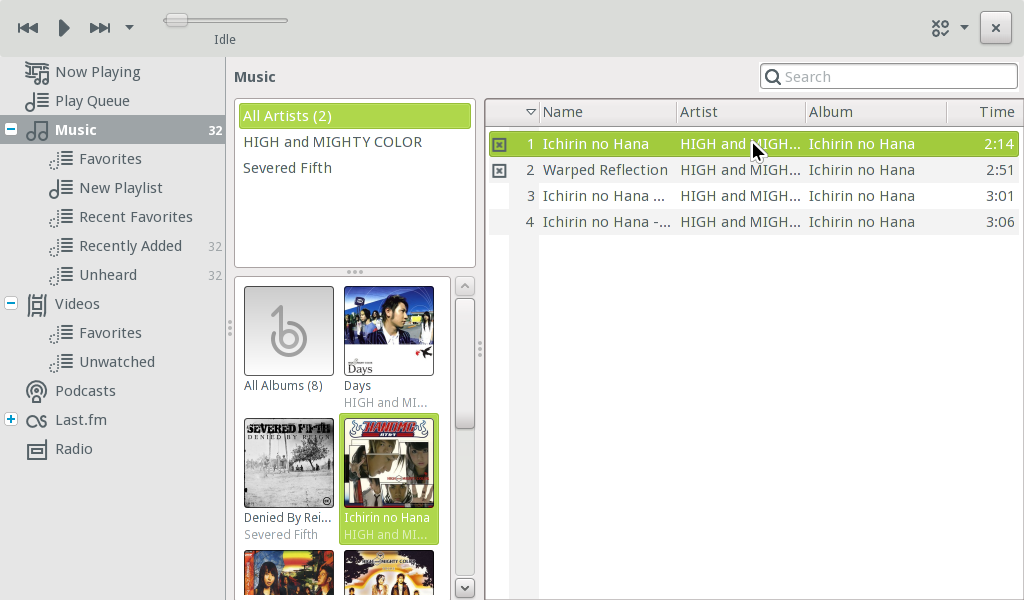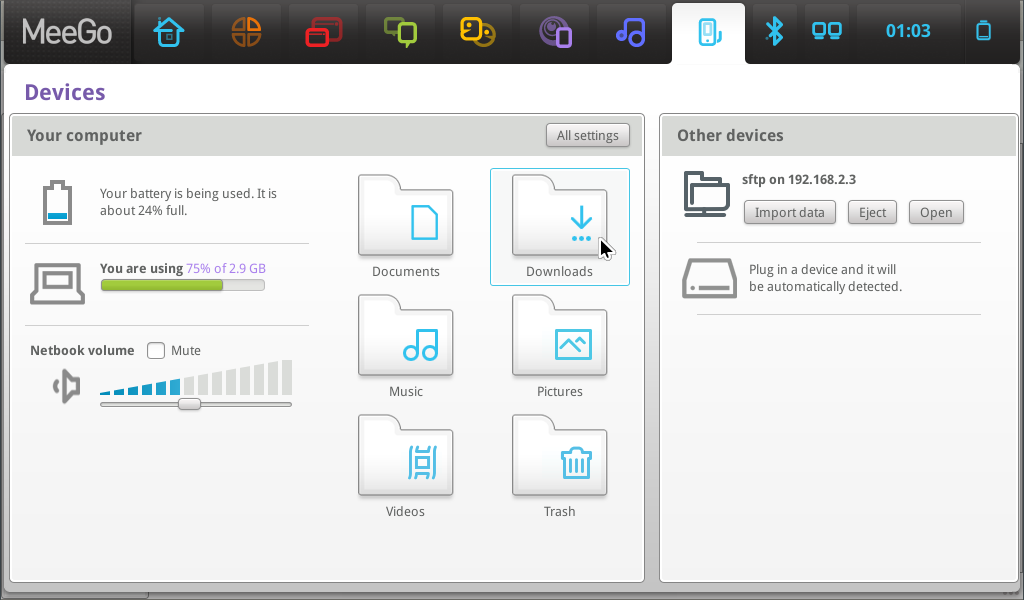Intel and Nokia joined forces earlier this year when they combined their mobile Linux operating systems to create MeeGo, an open source platform that is designed to support multiple hardware architectures and a wide range of mobile and embedded device form factors. The project officially launched last month when the source code and initial installable disk images became available.
The MeeGo project took another big step forward this week with the release of MeeGo 1.0 and the launch of the MeeGo Netbook User Experience project, which aims to deliver a MeeGo-based computing environment that is tailored for optimal performance and usability on netbook devices. The Netbook User Experience, which draws heavily from Intel's Moblin project, offers a rich user interface shell that is built with the open source Clutter framework. It is a much-improved version of the Moblin user interface that we explored last year and reviewed on the Dell Mini 10v.
Pragmatic compromises
We conducted extensive testing of the MeeGo 1.0 Netbook User Experience on the same Mini 10v to see how it compares to its Moblin predecessor. The underlying design philosophy is largely unchanged, but a number of significant differences are apparent in the application stack. In the transition from Moblin to MeeGo, Intel seems to have significantly reined in its ambitions by making a number of pragmatic compromises. Several components from Moblin that were built largely from scratch have been discarded in MeeGo in favor of existing Linux software.
A particularly noteworthy example of such an exchange is the Web browser. Moblin 2 had its own custom Web browser that brought together a unique Clutter-based user interface and Mozilla's Gecko HTML rendering engine. It was a very compelling idea because it opened the door to a browsing experience with rich visual affects and more fluid platform integration. Although the concept is intriguing in theory, it was very difficult for Intel to execute on. The custom browser was incomplete and somewhat dysfunctional when we reviewed Moblin last year. Intel has ditched the custom browser and chose to adopt Google Chrome for MeeGo.


Chrome is robust, increasingly mature, and beginning to attract a considerable following. The Ubuntu development community has also embraced Google's browser and recently chose to adopt it as the default for the next major version of the Ubuntu Netbook Edition. Placement in MeeGo, Ubuntu, and Chrome OS could potentially make Chrome the dominant Web browser on the next generation of Linux-based netbooks. It's a good choice for MeeGo, but the downside is that it will never have the kind of seamless integration that was possible with a custom browser.
Another area where compromise is evident is the e-mail client. Moblin's slick Anjal e-mail tool—a specialized front-end of GNOME's Evolution e-mail client—has been discarded in favor of Evolution Express, a new front-end that is more conventional. We praised Anjal in our review of Moblin 2 because it offered a novel approach to improving the e-mail experience on small screens. Evolution Express, by comparison, is little more than an incrementally pared down variation of Evolution's standard desktop user interface.
Although it is less innovative, Evolution Express is more robust and complete. It benefits from the maturity of the existing Evolution code base and is easier to maintain upstream. In a detailed blog entry, Novell's Michael Meeks recently described how Evolution Express was developed and explains the rationale behind the change in direction.
Despite the cuts, there is still a lot of innovation to be found in MeeGo 1.0 for netbooks. The Moblin shell, which is developed with the open source Clutter framework and provides easy access to key functionality of the platform, is still present in MeeGo and has a number of nice improvements. It's now possible to configure the tab order and select which tabs should be shown. MeeGo has also inherited Moblin's brilliant Zones system, an intuitive and self-managing variant of virtual desktops.

Banshee integration
Novell's excellent Banshee media player has been adopted for inclusion in the MeeGo project and is tightly integrated with the platform. The media tab in the MeeGo shell provides quick access to your Banshee music library and also has built in controls for playback. Clicking the Banshee icon on the media tab will launch a special version of Banshee that has been customized for small screens and conformance with MeeGo's visual style.


Banshee is a good choice for MeeGo because it is highly modular, easy to extend with plugins, and has a rich feature set. Banshee developer Aaron Bockover wrote a blog entry this week that discusses Banshee's MeeGo integration and some of the relevant technical details.
During our testing of MeeGo 1.0, we found that any MP3 files that are placed in the Music folder in the user's home directory will automatically be added to Banshee's library, making the music instantly accessible through the MeeGo shell's multimedia tab.
MeeGo has benefited from a lot of upstream improvements that have landed over the past year in several of the included desktop applications. The Empathy instant messaging client, for example, has matured considerably. Empathy is integrated very well in MeeGo, much like it was in Moblin. The People tab displays the user's buddy list, provides easy access to active conversations, and also has a convenient combo box for setting your status. During our tests, we connected it to Facebook Chat and found that it worked well.

Look and feel
MeeGo's look and feel builds on Moblin's style, but there are some noticeable differences. There are a lot more gradients, which give the widgets a somewhat stronger sense of depth. Bright colors are used for highlighting throughout the user interface. There is a lot of padding everywhere, particularly in the massive window titlebars. The collection of silhouette and tile icons—used in the shell and in applications—is much more complete and consistent.
Moblin really looked great, but there were places where the style was broken, not fully applied, or just inconsistent. A lot of those things have been fixed in MeeGo, giving a more complete view of the designers' aesthetic vision. It looks gorgeous, modern, and distinctive. The general feel of the thing is highly suggestive of an appliance, which is a very positive characteristic for a netbook user interface.
A number of the UI stylings are very well done, but the brightly colored highlights are a bit much in some places, particularly the rainbow icons in the shell tabs. It's worth noting that the style is still a work in progress. Although a number of the little glitches have been fixed, there are still a handful of things that are visibly broken—such as progress bars where the fill leaks out of the border.




Riddles in the dark
It's really important to understand that the MeeGo 1.0 Netbook builds that are made available by the MeeGo project are not a production-ready Linux distribution. The images include a core MeeGo environment, but are missing a lot of the things that you would need to make practical use of it on conventional netbook hardware. When we tested it on the 10v, we had to plug in an Ethernet cable because it did not support the device's WiFi hardware. It also lacked the proper configuration for the 10v touchpad and the media player was unable to play MP3 files due to lack of codec support.
These kinds of limitations aren't flaws in MeeGo per se; they merely reflect the fact that it's not a full Linux distro. Providing hardware drivers and codecs is left as an exercise for the hardware vendors that will be shipping MeeGo on their devices. Unfortunately, the downside is that regular end users who want to start playing with MeeGo today can't just install it on their personal netbooks with the expectation that it will function properly.
It's possible that a mainstream Linux distributor will fill that gap and offer a build of MeeGo on top of a full, conventional Linux distribution with proper hardware support and all of the other necessary features. Novell is the most likely candidate, because the company has worked very closely with Intel to develop a lot of MeeGo's functionality. The company also used to have an openSUSE Moblin variant nicknamed Goblin. One of the company's designers jokingly proposed the awesome name "Smeegol" (SUSE MeeGo Linux) for a possible openSUSE version of MeeGo, but it's still unclear if such a thing will be released.
Conclusion
Although we're a bit disappointed that the MeeGo netbook environment won't be able to deliver on Moblin's full potential at launch, the compromises make a lot of sense and are necessary in order to ensure that the product functions properly and meets the needs of users. The whole environment is decidedly less ambitious and innovative than Moblin, but the cuts aren't deep enough to undermine the core vision. In that sense, the trade-offs that the developers have made to get MeeGo to market on netbooks are sound. The user experience is good, the software functions well, and the look and feel is excellent.
Users who want to download it themselves can obtain the disk image from the MeeGo website. For additional details, see the official release announcement and release notes.
reader comments
40